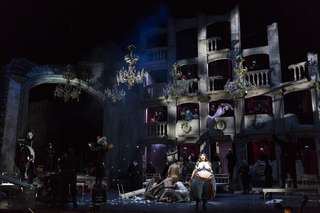|
Back
Les Indes Dénaturées Geneva
Grand Théâtre
12/13/2019 - & December 15, 17, 19*, 21, 23, 27, 29, 2019
Jean-Philippe Rameau : Les Indes galantes
Kristina Mkhitaryan (Hébé, Emilie, Zima), Roberta Mameli (Amour, Zaïre), Claire de Sévigné (Phani), Amina Edris (Fatime), Renato Dolcini (Bellone, Osman, Adario), Gianluca Buratto (Ali), Anicio Zorzi Giustiniani (Don Carlos, Damon), François Lis (Huascar, Don Alvaro), Cyril Auvity (Valère, Tacmas), Ballet du Grand Théâtre de Genève
Chœur du Grand Théâtre de Genève, Alan Woodbridge (chorus master), Cappella Mediterranea, Leonardo García Alarcón (conductor)
Lydia Steier (stage direction), Demis Volpi (choreography), Heike Scheele (sets), Katharina Schlipf (costumes), Olaf Freese (lighting), Krystian Lada (dramaturgy)

(© Magali Dougados)
This was a disappointing production of Rameau’s sublime opera. It’s a pity that stage directors are granted the freedom to deconstruct and denature dramatic works and to present parodies of great operas, especially in long-established opera houses, such as Geneva’s Grand Théâtre. Whereas French Baroque opera is the quintessence of elegance, Lydia Steier’s staging was its antithesis. Also tragic is the modest role choreography played in this production. Most of Rameau’s operas are actually opera-ballets where singing is elegantly fused with dance. Given Steier’s staging, the singers and would-be dancers were hipsters seeking refuge in an abandoned theatre. Instead of dancing, they were either fornicating or convulsing. Les Indes galantes was written as an opera-ballet divertimento celebrating love in exotic settings. Steier’s staging was possibly a celebration of depravity and chaos but certainly not love. But here the stage director has chosen to make Rameau’s opera a condemnation of war. Since the opera featured four exotic settings, it was also a pretext for condemning Western belligerence in the Third World. The premise may be interesting, but it is unrelated to the ballet-opera divertimento. Most importantly, sensual love is quite distinct from the sexual depravity that Steier favours. Dressed as Venus in Furs, this modern day Hebe, Goddess of Youth, set the tone for sexual depravity as the evening’s leitmotif. Seeming to attempt to counter the original elegance of Rameau’s opera, we are shown depressing hospital beds, provided for the amorous crowd’s orgies. The idea of an abandoned opera house for the setting was evocative and afforded some colour to contrast with the unappealing costumes. However, the hospital beds and the hideous costumes made this hideout seem like a wartime ad hoc syphilitic clinic or an insane asylum. More original was the idea of Hebe’s followers opening up boxes of costumes from previous opera productions in the abandoned theatre and dressing up as the protagonists of the opera’s four exotic scenes in, variously, a Turkish Harem; a Persian garden; among Peru’s Incas; and among North America’s natives.
The mostly non-native French-speaking cast displayed overall good diction. However, good diction alone is insufficient in French Baroque opera, especially in a French-speaking city. French opera of the period is famous for a certain declamatory style that was mostly absent in this production. Of course, this could be intentional, as it would appear incongruous with the hipster style of the protagonists. Most remarkable among the cast was French tenor Cyril Auvity, as Valère/Tacmas, who impressed with his beautiful timbre, clear diction and elegant vocal style. Canadian coloratura soprano Claire de Sévigné sang the role of the Peruvian Princess Phani delicately and movingly. Italian Baritone Renato Dolcini, as Bellone/Osman/Adario, impressed with his sonorous voice and French diction. Russian soprano Kristina Mkhitaryan, as Hébé/ Emilie/Zima, sang competently but lacked sufficient charisma for the leading role. Italian tenor Anicio Zorzi Giustiniani was an expressive singer but frequently sounded nasal.
Argentinian conductor Leonardo García Alarcón has been hailed as the champion of the relatively little-known early opera composer Cavalli. Though the Cappella Mediterranea played competently, they seemed to have little affinity for Rameau’s music. The opera’s numerous fast, joyous dances needed more brisk tempi here, to help animate them, while this production’s choreography lacked both imagination and energy. La Cappella Mediterranea’s production of Les Indes galantes was perhaps a bit too Mediterranean and not sufficiently French!
Ossama el Naggar
|